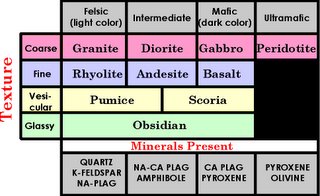Field classification

To employ this classification we must first determine the rock's texture. Click HERE if you wish to go to a discussion of igneous rock textures. You might remember we have five basic textures; phaneritic (coarse), aphanitic (fine), vesicular, glassy and fragmental (our classification doesn't bother with the latter because we often term all fragmental igneous rocks tuffs). Examine your rock and determine which textural group it belows to. If it is glassy, vesicular or fragmental you cannot determine mineralogy and hence the name is simply obsidian for a glass, tuff for a fragmental or pumice/scoria for a vesicular rock (the latter are differentiated on the basis or color and size of the vesicles or holes).
For the phaneritic and some aphanitic rocks you must determine the mineralogy. Often it is only necessary to identify one or two key minerals, not all of the minerals in the rock. For instance quartz and potassium feldspar (k-feldspar) are restricted to granites and rhyolites. Amphibole is only abundant in diorite or andesite, although minor amounts can be present in granite. How am I getting these names? Let's take an example. I pick up my first specimen and notice that it is distinctly coarse grained (phaneritic). This means that it must be one of the rocks in the row labeled coarse (i.e., granite, diorite, gabbro or peridotite). I next place the rock under a binocular microscope and identify the minerals plagioclase and pyroxene. I go to the bottom row of the chart (Minerals Present) and look for a match with my mineralogy. I find it in the third column (Ca-play, pyroxene) and read the name (gabbro) from the coarse row on the chart. Pretty simple!! Relax, when you actually begin your igneous rock identification we will walk you through it step by step. But remember to refer to the above classification diagram often as an aid.


0 Comments:
Post a Comment
<< Home